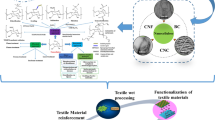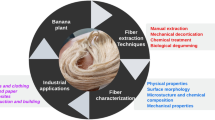Abstract
The development of green technologies to produce new biobased materials can minimize the dependence on fossil-based resources. The current study aimed to modify cellulose extracted from oat hull by employing a simple and ecofriendly process based on reactive extrusion using sodium trimetaphosphate (STMP) and tartaric acid (TA) as esterifying and cross-linking agents. STMP and TA were used at different concentrations (0, 5, 12.5, and 20% for TA and 0.025, 0.05, 0.1% for STMP). Reactive extrusion with STMP and TA did not change the morphology and crystallinity pattern of cellulose. Crystallinity indices ranged from 33 to 37% in modified samples, which presented higher affinity by the nonpolar solvent in wettability test and higher oil absorption capacity (7.26–8.60 g/g) when compared to unmodified cellulose (1.78 g/g). Reactive extrusion can be an effective and scalable technology for the modification of cellulose, resulting in materials with new characteristics and some advantages, such as low cost, short reaction times, low effluent generation and the use of nontoxic materials in all processes.
Graphical abstract









Similar content being viewed by others
References
Duque-Acevedo M, Belmonte-Ureña LJ, Cortés-García FJ, Camacho-Ferre F (2020) Agricultural waste: review of the evolution, approaches and perspectives on alternative uses. Glob Ecol Conserv 22:e00902. https://doi.org/10.1016/j.gecco.2020.e00902
Ubando AT, Felix CB, Chen W (2020) Biorefineries in circular bioeconomy: a comprehensive review. Bioresour Technol 299:122585. https://doi.org/10.1016/j.biortech.2019.122585
Zhu H, Han Z, Cheng ZH, Sun DW (2022) Modification of cellulose from sugarcane (Saccharum officinarum) bagasse pulp by cold plasma: dissolution, structure and surface chemistry analysis. Food Chem 374:131675. https://doi.org/10.1016/j.foodchem.2021.131675
Debiagi F, Faria-Tischer PCS, Mali S (2020) Nanofibrillated cellulose obtained from soybean hull using simple and eco-friendly processes based on reactive extrusion. Cellulose 27:1975–1988. https://doi.org/10.1007/s10570-019-02893-0
Gil-Giraldo GA, Mantovan J, Marim BM, Kishima JOF, Mali S (2021) Surface modification of cellulose from oat hull with citric acid using ultrasonication and reactive extrusion assisted processes. Polysaccharides 2:218–233. https://doi.org/10.3390/polysaccharides2020015
Marim MB, Mantovan J, Gil-Giraldo GA, Mali S (2021) Environmentally friendly process based on a combination of ultrasound and peracetic acid treatment to obtain cellulose from orange bagasse. J Chem Technol Biotechnol 96:630–638. https://doi.org/10.1002/jctb.6576
Cagnin C, Simões BM, Yamashita F, Andrello AC, Carvalho GM, Grossmann MVE (2021) Hydrogels of starch/carboxymethyl cellulose crosslinked with sodium trimetaphosphate via reactive extrusion. J Appl Polym Sci 138:e50194. https://doi.org/10.1002/app.50194
Cagnin C, Simões BM, Yamashita F, Carvalho GM, Grossmann MVE (2021) pH sensitive phosphate crosslinked films of starch-carboxymethyl cellulose. Polym Eng Sci 61:388–396. https://doi.org/10.1002/pen.25582
Hubbe MA, Gardner DJ, Shen W (2015) Contact angles and wettability of cellulosic surfaces: a review of proposed mechanisms and test strategies. BioResources 10:8657–8749. https://doi.org/10.15376/biores.10.4.8657-8749
Ma JG, Li X, Bao Y (2015) Advances in cellulose-based superabsorbent hydrogels. RSC Adv 5:59745. https://doi.org/10.1039/C5RA08522E
Maaloul N, Oulego P, Rendueles M, Ghorbal A, Diaz M (2021) Enhanced Cu(II) adsorption using sodium trimetaphosphate-modified cellulose beads: equilibrium, kinetics, adsorption mechanisms, and reusability. Environ Sci Pollut Res 34:446523–446539. https://doi.org/10.1007/s11356-020-10158-8
Pang L, Gao Z, Feng H, Wang S, Wang Q (2019) Cellulose based materials for controlled release formulations of agrochemicals: a review of modifications and applications. J Control Release 316:105–115. https://doi.org/10.1016/j.jconrel.2019.11.004
Zainal SH, Mohd NH, Suhaili S, Anuar FH, Lazim LM, Othaman R (2021) Preparation of cellulose-based hydrogel: a review. J Mater Res Techno 10:935–952. https://doi.org/10.1016/j.jmrt.2020.12.012
Ponnusamy PG, Sundaram J, Mani S (2022) Preparation and characterization of citric acid crosslinked chitosan-cellulose nanofibrils composite films for packaging applications. J Appl Polym Sci 139:e52017. https://doi.org/10.1002/app.52017
Tan T, Zhou J, Gao X, Tang X, Zhang H (2021) Synthesis, characterization and water-absorption behavior of tartaric acid-modified cellulose gel fromcorn stalk pith. Ind Crop Prod 169:113641. https://doi.org/10.1016/j.indcrop.2021.113641
Sechi NSM, Marques PT (2017) Preparation and physicochemical, structural and morphological characterization of phosphorylated starch. Mater Res 20:174–180. https://doi.org/10.1590/1980-5373-MR-2016-1008
Seker M, Hanna MA (2006) Sodium hydroxide and trimetaphosphate levels affect properties of starch extrudates. Ind Crops Prod 23:249–255. https://doi.org/10.1016/j.indcrop.2005.08.002
Kim CT, Do K, Shih FF, Champagne ET, Daigle K (1999) Effects of phosphorylating salts and temperature on the preparation of rice starch phosphates by extrusion. Starch/Stärke 51:208–286
Li BZ, Wang LJ, Li D, Chiu YL, Zhang ZJ, Shi J, Mao ZH (2009) Physical properties and loading capacity of starch-based microparticles crosslinked with trisodium trimetaphosphate. J Food Eng 92:255–260. https://doi.org/10.1016/j.jfoodeng.2008.10.008
Ma X, Liu C, Anderson DP, Chang PR (2016) Porous cellulose spheres: preparation, modification and adsorption properties. Chemosphere 165:399–408. https://doi.org/10.1016/j.chemosphere.2016.09.033
Reshma G, Reshmini CR, Nair SV, Menon D (2020) Superabsorbent sodium carboxymethyl cellulose membranes based on a new cross-linker combination for female sanitary napkin applications. Carbohyd Polym 248:116763. https://doi.org/10.1016/j.carbpol.2020.116763
Heebthong K, Ruttarattanamongkol K (2016) Physicochemical properties of cross-linked cassava starch prepared using a pilot-scale reactive twin-screw extrusion process (REX). Starch-Stärke 68:528–540. https://doi.org/10.1002/star.201500065
Alimi BA, Workneh TS (2018) Structural and physicochemical properties of heat moisture treated and citric acid modified acha and iburu starches. Food Hydrocoll 81:449. https://doi.org/10.1016/j.foodhyd.2018.03.027
Simões BM, Cagnin C, Yamashita F, Olivato JB, Garcia PS, Mali S, Grossmann MVE (2020) Citric acid as crosslinking agent in starch/xanthan gum hydrogels produced by extrusion and thermopressing. LWT 125:108950. https://doi.org/10.1016/j.lwt.2019.108950
Sun S, Liu O, Ji N, Hou H, Dong H (2018) Effects of various cross-linking agents on the physicochemical properties of starch/PHA composite films produced by extrusion blowing. Food Hydrocoll 77:964–975. https://doi.org/10.1016/j.foodhyd.2017.11.046
Pereira JF, Marim BM, Mali S (2022) Chemical modification of cellulose using a green route by reactive extrusion with citric and succinic acids. Polysaccharides 3:292–305. https://doi.org/10.3390/polysaccharides3010017
Tao X, Nonaka H (2021) Wet extrusion molding of wood powder with hydroxypropylmethyl cellulose and with citric acid as a crosslinking agent. BioResources 16:2314–2325. https://doi.org/10.15376/biores
Spiridon J, Teacǎ CA, Bodîrlǎu R, Bercea M (2013) Behavior of cellulose reinforced cross-linked starch composite films made with tartaric acid modified starch microparticles. J Polym Environm 21:431–440. https://doi.org/10.1007/s10924-012-0498-2
Formela K, Zedler L, Hejna A, Tercjak A (2018) Reactive extrusion of bio-based polymer blends and composites—current trends and future developments. Express Polym Lett 12:24–57. https://doi.org/10.3144/expresspolymlett.2018.4
Moad G (2011) Chemical modification of starch by reactive extrusion. Prog Polym Sci 36:218–237. https://doi.org/10.1016/j.progpolymsci.2010.11.002
Gaudino EC, Grillo G, Manzoli M, Tabasso S, Maccagnan S (2022) Mechanochemical applications of reactive extrusion from organic synthesis to catalytic and active materials. Molecules 27:449. https://doi.org/10.3390/molecules27020449
Van Soest PJ (1965) Symposium on factors influencing the voluntary intake of herbage by ruminants: voluntary intake in relation to chemical composition and digestibility. J Anim Sci 24:834–843. https://doi.org/10.2527/jas1965.243834x
TAPPI (1999) Test method T222 om-88, acid-insoluble lignin in wood and pulp, in Tappi test methods. Tappi Press, Atlanta
Volkert B, Lehmann A, Greco T, Nejad MH (2010) A comparison of different synthesis routes for starch acetates and the resulting mechanical properties. Carbohyd Polym 79:571–577. https://doi.org/10.1016/j.carbpol.2009.09.005
MAPA (2014) Ministério da agricultura, pecuária e abastecimento. Determinação colorimétrica de fósforo total em produtos deorigem animal. Código, MET POA/SLAV/31/02/01
Segal L, Creely JJ, Martin AE, Conrad CM (1959) An empirical method for estimating the degree of crystallinity of native cellulose using the x-ray diffractometer. Text Res J 29:786–794. https://doi.org/10.1177/004051755902901003
Lu H, Gui X, Zheng L, Liu X (2013) Morphological, crystalline, thermal and physicochemical properties of cellulose nanocrystals obtained from sweet potato residue. Food Res Int 50:121–128. https://doi.org/10.1016/j.foodres.2012.10.013
Namazi H, Dadkhah A (2010) Convenient method for preparation of hydrophobically modified starch nanocrystals with using fatty acids. Carboh Polym 79:731–737. https://doi.org/10.1016/j.carbpol.2009.09.033
Bizot H (1983) Using the gab model to construct sorption isotherms. In: Jowitt R, Escher F, Hallistrom B, Meffert HFT, Spiess WWL, Vos G (eds) Physical properties of foods. Applied Science Publishers, London, pp 43–54
Yoshimura T, Matsuo K, Fujioka R (2006) Novel biodegradable superabsorbent hydrogels derived from cotton cellulose and succinic anhydride: synthesis and characterization. J App Polym Sci 99:3251–3256. https://doi.org/10.1002/app.22794
Oliveira JP, Bruni GP, Lima KO, El-Halal SLM, Rosa GS, Dias ARG, Zavareze ER (2017) Cellulose fibers extracted from rice and oat husks and their application in hydrogel. Food Chem 221:153–160. https://doi.org/10.1016/j.foodchem.2016.10.048
Dong H, Vasanthan T (2020) Amylase resistance of corn, faba bean, and field pea starches as influenced by three different phosphorylation (cross-linking) techniques. Food Hydrocoll 101:105506. https://doi.org/10.1016/j.foodhyd.2019.105506
Manoi K, Rizvi SSH (2010) Physicochemical characteristics of phosphorylated cross-linked starch produced by reactive supercritical fluid extrusion. Carbohydr Polym 81:687–694. https://doi.org/10.1016/j.carbpol.2010.03.042
Mantovan J, Gil-Giraldo GA, Marim BM, Garcia PS, Baron AM, Mali S (2021) Cellulose-based materials from orange bagasse employing environmentally friendly approaches. Biomass Convers Biorefin 24:132–142. https://doi.org/10.1007/s13399-021-01279-2
Duan L, Yu W, Li Z (2017) Analysis of structural changes in jute fibers after peracetic acid treatment. J Eng Fiber Fabr 12:33. https://doi.org/10.1177/155892501701200104
Lee HR, Kazlauskas RJ, Park TH (2017) Mild pretreatment of yellow poplar biomass using sequential dilute acid and enzymatically-generated peracetic acid to enhance cellulase accessibility. Biotechnol Bioprocess Eng 22:405–412. https://doi.org/10.1007/s12257-017-0139-7
Ramírez JAA, Fortunati E, Kenny JM, Toree J, Foresti ML (2017) Simple citric acid-catalyzed surface esterification of cellulose nanocrystals. Carbohyd Polym 157:1358–1364. https://doi.org/10.1016/j.carbpol.2016.11.008
El-Halal SLM, Colussi R, Deon VG, Pinto VZ, Villanova FA, Carreño NLV, Dias ARG, Zavareze ER (2015) Films based on oxidized starch and cellulose from barley. Carbohyd Polym 133:644–653. https://doi.org/10.1016/j.carbpol.2015.07.024
Johar N, Ahmad I, Dufresne A (2012) Extraction, preparation and characterization of cellulose fibres and nanocrystals from rice husk. Ind Crops Prod 37:93–99. https://doi.org/10.1016/j.indcrop.2011.12.016
Hammouda S, Chen Z, An C, Lee K (2021) Recent advances in developing cellulosic sorbent materials for oil spill cleanup: a state-of-the-art review. J Clean Prod 311:127630. https://doi.org/10.1016/j.jclepro.2021.127630
Miranda MIG, Bica CID, Nachtigall SMB, Rehman N, Rosa SML (2013) Kinetical thermal degradation study of maize straw and soybean hull celluloses by simultaneous DSC–TGA and MDSC techniques. Thermochim Acta 565:65–71. https://doi.org/10.1016/j.tca.2013.04.012
Alharbi K, Ghoneim A, Ebid A, El-Hamshary H, El-Newehy MH (2018) Controlled release of phosphorous fertilizer bound to carboxymethyl starch-g-polyacrylamide and maintaining a hydration level for the plant. Int J Biol Macromol 116:224–231. https://doi.org/10.1016/j.ijbiomac.2018.04.182
Cunha AG, Zhou Q, Larsson PT, Berglund LA (2014) Topochemical acetylation of cellulose nanopaper structures for biocomposites: mechanisms for reduced water vapour sorption. Cellulose 21:2773–2787. https://doi.org/10.1007/s10570-014-0334-z
Merci A, Urbano A, Grossmann MVE, Tischer CA, Mali S (2015) Properties of microcrystalline cellulose extracted from soybean hulls by reactive extrusion. Food Res Int 73:38–43. https://doi.org/10.1016/j.foodres.2015.03.020
Vercelheze AES, Marim BM, Oliveira ALM, Mali S (2019) Development of biodegradable coatings for maize seeds and their application for Azospirillum brasilense immobilization. Appl Microbio Biotechnol 103:2193–2203. https://doi.org/10.1007/s00253-019-09646-w
Salleh KM, Zakaria S, Sajab MS, Gan S, Kaco H (2019) Superabsorbent hydrogel from oil palm empty fruit bunch cellulose and sodium carboxymethylcellulose. In J Biol Macromol 131:50–59. https://doi.org/10.1016/j.ijbiomac.2019.03.028
Acknowledgements
We thank the Laboratory of Spectroscopy (ESPEC), Laboratory of Electronic Microscopy and Microanalysis (LMEM) and Laboratory of X-ray Analysis (LARX) of the State University of Londrina for the analyses. CAPES-Brazil for the doctorate grant of Gina Alejandra Gil Giraldo, Janaina Mantovan and Beatriz M. Marim (CAPES-DS) and CAPES (Cod. 001). FINEP (01.21.0126.00-REF. 0128/2021) for financial support.
Author information
Authors and Affiliations
Corresponding author
Ethics declarations
Conflict of interest
There are no competing interests to declare.
Additional information
Publisher's Note
Springer Nature remains neutral with regard to jurisdictional claims in published maps and institutional affiliations.
Rights and permissions
Springer Nature or its licensor (e.g. a society or other partner) holds exclusive rights to this article under a publishing agreement with the author(s) or other rightsholder(s); author self-archiving of the accepted manuscript version of this article is solely governed by the terms of such publishing agreement and applicable law.
About this article
Cite this article
Marim, B.M., Mantovan, J., Pereira, J.F. et al. Sustainable process based on reactive extrusion to modify cellulose from oat hull with sodium trimetaphosphate and tartaric acid. Polym. Bull. 81, 2345–2364 (2024). https://doi.org/10.1007/s00289-023-04825-2
Received:
Revised:
Accepted:
Published:
Issue Date:
DOI: https://doi.org/10.1007/s00289-023-04825-2




